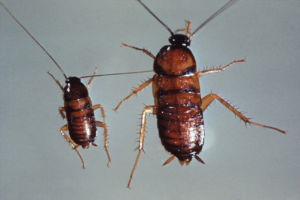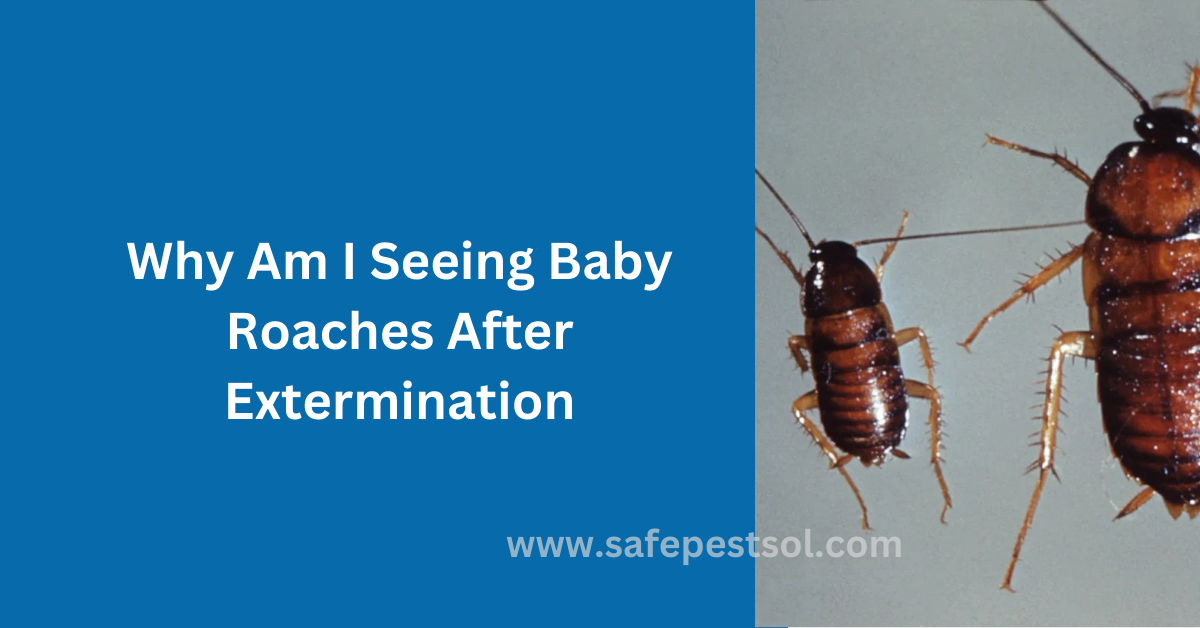Why Am I Seeing Baby Roaches After Extermination
Sometimes, after performing extermination, you still see a few baby roaches roaming in your kitchen, cupboard, and washrooms. Let us tell you, dealing with baby roaches can be sometimes difficult even after doing pest control. So why are you still seeing baby cockroaches, even after you did everything you could? Is it normal?
Don’t worry, this blog has all the answers. Read this guide till the end and you will know everything you are searching for.

Life Cycle of Cockroaches and Reproduction Duration
Before knowing why you are seeing baby cockroaches even after doing extermination, you first have to understand their life cycle. Baby pests of German cockroaches’ life include their birth, laying eggs and nymphs or baby cockroaches, and their death.
So here is the table that can help you understand the life cycle of most common household roaches, such as American and German Cockroaches.
Category | German Cockroach | American Cockroach |
| Preferred Habitat | Prefers indoor humidity | Often found in darker, less frequented parts of a home |
| Egg Cases (Oothecae) | Up to 6 oothecae in a lifetime | 6 to 14 egg cases |
| Eggs per Ootheca | About 30-40 eggs | Approximately 16 eggs |
| Potential Offspring | Up to 240 (assuming maximum eggs per ootheca) | Up to 224 per female (based on egg cases); around 800 throughout her life |
| Developmental Rate | Quick maturation from baby cockroaches to adults | 6 months to over a year from egg to adult |
| Population Growth Potential | Can explode rapidly without proper roach control | Rapid growth in favorable conditions, slower in unfavorable ones |
4 Reasons Why You Are Seeing Baby Roaches After Extermination
1. The Eggs Survived the Treatment
Cockroach eggs tend to conceal themselves in cracks or behind walls, and they are highly resilient. In most cases, the extermination treatment would not have affected the eggshells. Such eggs, called ootheca, can be perfectly safe in warm places and only hatch into baby roaches later.
This does not mean the treatment did not work; it merely means that the treatment did not attack the eggs. Baby roaches appearing after an extermination indicate that these eggs were not taken out.
2. Incomplete Extermination
Some treatments may kill most of the adult cockroaches but not eliminate the entire cockroach infestation. Some of the hidden adults or babies may reemerge again.
Some chemicals or methods used may not have been strong enough to kill all the pests, especially during a serious infestation in which a few roaches survive and then repopulate over time.
3. Hatching from Hidden Areas
Cockroaches like to stay in areas where they can hide easily, including behind cabinets, wall cracks, or even under appliances. Due to this, there is a high possibility that extermination cannot reach all the areas; hence, eggs or baby cockroaches may survive and become re-born.
The pests prefer damp places; they like their environment to be dark-colored with chances of remaining hidden for a long period. In most cases, they tend to be attracted by crumbs or water sources that may still be present.
4. Reinfestation from Nearby Areas
Even if the cockroaches were killed, they can migrate from nearby locations. This is especially true for apartment complexes or closely spaced houses. The roaches can enter your house again to find food, warm places, and shelter.
In most cases, this could be one of the reasons why you may find many baby cockroaches after extermination. For example, German cockroaches and other species are very efficient at exploring ways to get into new spaces.
How You Can Get Rid of Baby Roaches After Extermination
Seal All Entry Points
Use caulk or other plastering materials to rough up entrance points, entry holes in your doors, and even tiny cracks where the plumbing is, and seal them. Observe the areas where your windows, doors, and pipes are.
This minimizes the possibility of new roaches coming in, especially where they may breed and survive, which is in moist areas.
Deep Clean Your Home
After extermination, make sure to keep the place clean. Cockroaches draw their attraction towards food and water sources; therefore, ensure that there is nothing to make them eat.
Clean countertops and floors and any cracks where crumbs might pile up. Also, store your food in covered containers and make sure that all the water pipes are working without leakages, as cockroaches can survive for a very long period with little moisture.
Use Traps and Sprays
Even if exterminated, it will be a good thing to use supplementary techniques such as traps and sprays to ensure any baby cockroaches remaining still get killed.
Place your roach traps in any warm places where you have noticed activities like a kitchen and bathroom. Use your anti-cockroach gels to avoid the unseen roach behind, especially those in damp rooms.
Call a Licensed Exterminator
If the baby cockroaches keep coming, then it would likely be time to once again call an exterminator since the little cockroaches can re-birth again. A licensed exterminator would assess the situation and then use stronger chemical treatments or offer some other alternative solution that can outsmart and eliminate a cockroach that does not want to leave.
Sometimes, it is bigger than you thought and may require other solutions beyond your pest control equipment and chemicals.
How Long Do Baby Roaches Take to Grow Into Adults?
Once they hatch, the baby roaches develop through successive instars. Instars is the duration where they molt and increase in size each time and they eventually become adults. The period it takes one to grow up from the baby cockroach stage is different for different species.
For example, one German baby cockroach matures in six weeks while others of the oriental or American species may take much more time.
Since these baby roaches mature into adults, they breed speedily, meaning the infestation could worsen. Therefore, you may have to face a serious problem since you are not just seeing little bugs but can actually see future breeders in them. The problem can worsen from a couple of roach babies to a major pest overnight if unchecked soon.
Conclusion
It is frustrating when roaches start re-emerging after an extermination but it’s normal. The main reasons why you are still seeing baby cockroaches after extermination can be survived eggs and are inadequate.
However, constant effort with the right measures will manage to eliminate the pests once and for all. Cleansing regularly, sealing entry points, and applying traps or sprays are some of the most effective ways to ensure that the cockroaches do not return. Always remember to seek the help of professionals if they persist.
FAQs
Why do I still see baby roaches after an extermination?
After extermination, it’s common to see baby cockroaches because their eggs may have survived the treatment. These eggs hatch into baby roaches, which are often more visible after adult roaches are eliminated.
How long after extermination will I see baby roaches?
You might see baby cockroaches for a few days or weeks after extermination as eggs continue to hatch. However, their numbers should decrease over time. If they don’t, it could indicate a larger infestation.
Can I prevent baby roaches after extermination?
Yes. Sealing cracks, maintaining a clean home, and using additional treatments like sprays and traps can help prevent re-infestation. Regular pest control inspections are also recommended, especially in areas prone to pests.
What should I do if baby cockroaches keep appearing?
If you continue to see baby roaches despite your efforts, it’s best to call a licensed exterminator for a thorough inspection and additional treatments. They can offer professional solutions to completely eliminate the infestation.
We Have The Solution to Eliminate Pests!
Tried everything but still found no way to wipe out bugs infestation? Try out our expertise today as we have expert pest control services for you.

